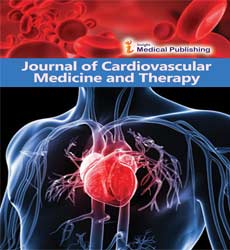Enlargement in Arterial Stiffness Estimates after Bariatric Surgery
Department of Cardiac Rehablitation, Jinan University, Guangzhou, China
- Corresponding Author:
- Yorley S
Department of Cardiac Rehablitation, Jinan University, Guangzhou, China
E-mail: yorleysan@yahoo.com
Received date: February 01, 2021; Accepted date: February 15, 2021; Published date: February 22, 2021
Citation: Yorley S (2021) Enlargement in Arterial Stiffness Estimates after Bariatric Surgery. J Cardiovasc Med Ther Vol.4 No.1: 02
Abstract
Keywords
Bariatric surgery; Arterial stiffness; Blood pressure
Description
The arteries are the blood vessels which supply oxygen and vital nutrients to all the vital organs and peripheries in the body. The heart sends blood through these vessels and with each pulse blood flows to distal circulation. With the conversion of each pulse into sufficient circulation, a system is developed. At each systole (beat of the heart), the heart compress to pump out blood. At each diastole the heart gets time to fill up with blood. The pressure applied on the walls of the blood vessels or arteries during the systole is shortest if the blood vessels are of high concurrence or low stiffness. Thus people who have flexible and highly acquiescent arterial walls have a narrow pulse pressure. Pulse pressure, means the systolic pressure minus the diastolic pressure [1]. This reflects low aortic wall tension. Low wall tension means that the workload of the heart is low. The stiffer and harder the blood vessel walls, the broader the pulse pressure and more the heart has to work to send blood into the arteries.
Discussion
In persons with stiffer arterial walls only a small fraction of each cardiac stroke volume can be used for blood circulation without increasing the blood pressure [2]. Thus to recompense for the lack of blood in the peripheries the blood pressure rises. These persons thus have approximately high systolic and pulse pressures and a low diastolic pressure. The relationship between obesity and arterial stiffness is multiplex, with a potential interaction by age and differ reports on the effect of lifestylebased on weight loss of arterial stiffness. Tiny is recognized about post-bariatric surgery changes in arterial stiffness. This study pointed to examine post-bariatric surgery changes in arterial stiffness and identify factors associated with greater changes in arterial stiffness. In 72 patients (mean age 44.5 years, 72.2% female), we estimated two arterial stiffness measures, cardio-ankle vascular index (CAVI) and heart-ankle pulse wave velocity (haPWV), one month initial to and 6 months after bariatric surgery. Another follow-up visit happened and conducted 12 months after bariatric surgery in a subset of 58 participants. Six months after bariatric surgery, an apparent decrease was seen in body mass index, heart rate, and systolic blood pressure. In contrast, both CAVI and haPWV significantly increased at 6 months (+0.64 [0.42, 0.87] and +0.24 [0.04, 0.44] m/s, respectively). Arterial stiffness [3] estimates, CAVI and haPWV, were raised after bariatric surgery despite other favorable cardio metabolic changes. Further studies are necessary to explain the underlying mechanism and prognostic implications of this elevation in arterial stiffness measures after bariatric surgery [4,5]. The arterial wall stiffness hangs on the structural elements within the arterial wall for example muscle, elastin and collagen. These support the pressure on the wall when the wall is swollen. In the circulatory system there are various sites where there is interference resistance or impedance.
Conclusion
This involves arterial branch points, places where there is stagnation of flow, and areas where the lumen diameter make a move from large to small or vice versa. Every pulse gives rise to a compression wave that comes from the contraction of the heart. These compression waves of pressure and associated velocity are recognized by Doppler analysis. These waves travel speeder than the velocity of the column of blood. When it encounters an obstacle the pressure wave bounce back to some extent. The assimilation interaction starts in the mouth where food is bitten and blended in with salivation and other compound containing discharges. Bariatric medical procedure is intended to adjust or intrude on this absorption interaction so food isn't separated and retained in the typical manner. A decrease in the measure of supplements and calories ingested empowers patients to get thinner and abatement their danger for weight related wellbeing dangers or issues.
References
- Flint AC, Conell C, Ren X, Banki NM, Chan SL, et al. (2019). Effect of systolic and diastolic blood pressure on cardiovascular outcomes. NEJM 381: 243-251.
- Palatini, Paolo, Grassi, Guido (2011). The morning blood pressure surge: A dynamic and challenging concept. J Hypertens 29: p 2316-2319.
- Kim HL, Lim WH, Seo JB, Kim SH, Zo ZH, et al. (2019). The comparison of the impact of arterial stiffness and central pressure on left ventricular geometry and diastolic function. BMC 25: 18.
- Wolfe BM, Kvach E, Eckel RH (2016). Treatment of obesity: Weight loss and bariatric surgery. PMC 118: 1844-1855.
- Oh YS (2018). Arterial stiffness and hypertension. BMC 24: 17.
Open Access Journals
- Aquaculture & Veterinary Science
- Chemistry & Chemical Sciences
- Clinical Sciences
- Engineering
- General Science
- Genetics & Molecular Biology
- Health Care & Nursing
- Immunology & Microbiology
- Materials Science
- Mathematics & Physics
- Medical Sciences
- Neurology & Psychiatry
- Oncology & Cancer Science
- Pharmaceutical Sciences
